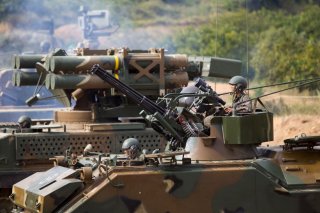North Korea’s Air Force Won’t Have Any Easy Time Attacking South Korea
The original Biho was built in the 1990s as a simple dual-gun design, similar to the German Gepard AA gun.
Here's What You Need to Remember: The Biho II has yet to be produced in any form. While such a highly modular system might look good on paper and in presentations to military officials, whether the system actually works has yet to be proven.
South Korea’s K30 Biho Self-Propelled Anti-Aircraft Gun (SPAAG) rose to international prominence when it beat out Russia’s Pantsir system for a massive Indian contract. While this contract is being disputed with the Indian government, it is worth looking at the Biho as it was considered to be one of the best anti-air systems in the world prior to the Indian contract.
The system has seen significant evolution in recent years, with most Korean K30s being upgraded to the new “Hybrid Biho” standard and the new “Biho II” being offered for export. But how do these improve on the original design?
The original Biho was built in the 1990s as a simple dual-gun design, similar to the German Gepard AA gun. However, unlike the Gepard and Shilka, the K30 Biho utilizes an electro-optical sensor on the visible and infrared bands to track and engage the targets. It only uses the radar for searching for targets.
The decision to use an electro-optical sensor for final engagement is likely due to the poor performances engagement radars generally give for targets obscured by ground clutter. The ill-fated M247 Sergeant York produced by the United States in the late stages of the Cold War suffered from these issues, so the South Koreans probably tried to avoid these issues by using an electro-optical sensor for tracking and engagement. Russia’s competing Tunguska and Pantsir systems utilize both radar and electro-optical systems for tracking and engagement.
Surface-to-air missiles (SAMs) were added to the Biho in 2013 to increase its effective range. The “Shingung” missile doubles the effective range of the system, out to seven kilometers. The gun and missile configuration is referred to as the “hybrid Biho” and was ordered by the South Korean military in 2015. The Hybrid Biho was the model that prevailed in the Indian competition against the Tunguska and Pantsir.
But the Biho’s manufacturer, Hanwha Defense Systems is already looking for more contracts. Their successor to the Biho, the Biho II, is more a modular anti-aircraft solution than a single vehicle.
The Biho II revolves around a modular turret, which can mount a 3D radar, an electro-optical sensor, and an additional tracking radar. From marketing materials, the tracking radar appears to be for “C-RAM,” or shooting at unguided artillery projectiles that may be too small or fast to be picked up on electro-optical sensors. All of the sensors and their mounts are meant to be modular on the Biho II, with different configurations for different roles being possible, including radar or EOTS-only turrets.
The new turret also appears to be designed to accommodate a variety of guns. Slides about the Biho II suggest that it could mount 30mm, 35mm, or 40mm guns depending on customer preference. The missile fit of the Biho II is also designed to be modular, with short-range SAMs, medium-range SAMs, and even anti-tank missiles presented as options that could be mounted to either side of the turret in pods. One configuration shows the Biho II system as a tracked vehicle mounting two quad-packs of AIM-9X anti-air missiles.
The “base” the turret is mounted on is also meant to be flexible. The Biho II can be self-propelled, it can be mounted on a towed base, or it can be put on a truck.
However, the Biho II has yet to be produced in any form. While such a highly modular system might look good on paper and in presentations to military officials, whether the system actually works has yet to be proven. Putting together various configurations might prove complicated despite the integrated and networked nature of modern electronic systems.
Charlie Gao studied Political and Computer Science at Grinnell College and is a frequent commentator on defense and national security issues.
This piece was first published last year and is being republished due to reader interest.
Image: Wikipedia.

